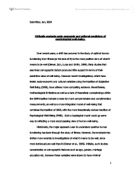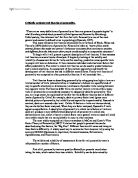Critically evaluate how psychological theories, concepts and evaluations have been employed forensic area of applied psychology covered in the module
Critically evaluate how psychological theories, concepts and evaluations have been employed forensic area of applied psychology covered in the module
Forensic psychology can be defined as a “branch of applied psychology which is concerned with the collection, examination and presentation of evidence for judicial purposes” (Gudjonsson and Haward, 1998). However this is a limited definition as it refers only to the application in law courts when in reality its scope is much wider, involving teaching, researching, prisons and the probation services. It is a recent development (the last 25 years) that advances past retribution and embraces a utilitarian and humanitarian dichotomy. A majority of forensic work is based in prisons and at the core is the risk assessment of offenders that aims to predict the future behaviour of that individual. These predictions dictate the appropriate treatments for the offender. This essay will explore the strengths and weaknesses of the theories relating to the treatments in prison, focusing on the most widely used cognitive behavioural therapy. It will then lead on to critically examine the tools involved within this treatment practice before assessing the research that proves this type of intervention to be successful.
Historically, Governments have taken varying views on the most effective way to tackle crime. They have been ‘soft on crime’ and ‘tough on crime’. ‘Prison works’ and ‘Nothing works’. Psychological theories have been viewed to be too soft on crime and are not successful in the fight against it, but it has since been proven within the criminological discipline that punishment is not effective for all offenders, as not all commit as rational actors. Sexual offenders provide an example to support this. The treatment of such offenders has become a priority in recent years as evidence shows a dramatic 50% increase in the decade 1980-90 of these types of crime (Fisher and Beech, 1999). It is a serious social problem and a long term issue and cannot be tackled by incarceration alone. Freud and his psychodynamic theories deemed sex offenders untreatable, but developments have resulted in cognitive and behavioural treatment programmes that are proven to reduce recidivism (Hanson et al, 2002).
Risk assessment is at the core of all forensic work carried out in prisons and essential before any such treatment programme can be applied, or before the release of violent offenders. It combines empirical research and clinical judgement to assess the likelihood of re-offence and the level of danger of that offence. For example, an inmate may be at high risk of re-offence but will pose a relatively low threat to society, or may be at low risk of re-offending but a high risk to society. These risks are not fixed through context or time. Empirical methods use the Psychopathy Checklist Revised (PCL-R) which identifies the broad relationship between risk factor and risk. It screens for psychopathic features by assessing the affective, internal, behavioural and deviant features of an individual using a variety of sources (e.g. observation, self reports) The psychologist can then carefully evaluate the individual according to the results. The success of this risk assessment can be shown in a study by Clark (1999) which followed individuals convicted of sexual offences for ten years. At the end of this period a quarter of those categorised as high risk were reconvicted of a violent crime. However other research throws shadows upon the effectiveness as a tool to predict future behaviour, as no stable risk factors can be identified. It can only successfully predict re-offence of a violent nature and is not valuable in predicting re-offence of a sexually violent nature (Rice,1997). The uncertainty of risk assessment, which serves to predict behaviour of individuals upon release and is a basis for future treatment programmes, is a worrying revelation. This is impacted further with the lack of evidence of its ability to predict a serious criminal offence in individuals that have not been convicted, and these pose the greatest threat to society (Rice, 1997). It is apparent, with the introduction of the PCL-R that statistical prediction aims to replace clinical prediction with empirically based methods. The theory is that predictions can be made on the basis of the relationships between predictor variables (demographic factors) and reoffending variables (appropriate measures of recidivism) on an extensive database. This appears simple but in reality is more complicated due to the complex nature of people.








